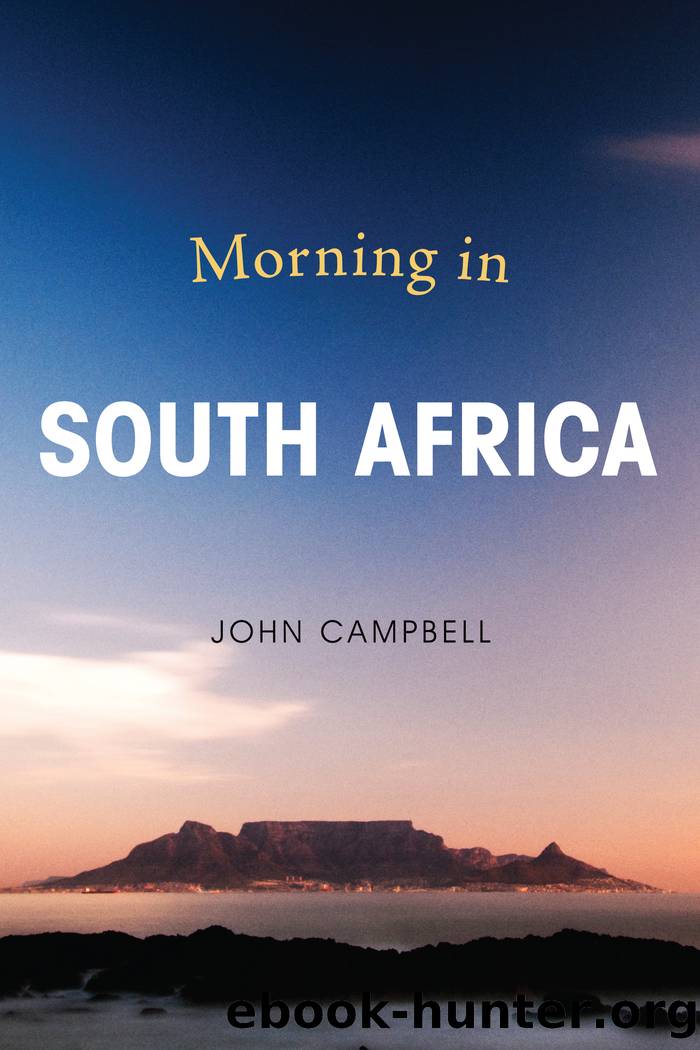Morning in South Africa by Campbell John;

Author:Campbell, John;
Language: eng
Format: epub
Tags: undefined
Publisher: Rowman & Littlefield Publishers
Published: 2012-08-15T00:00:00+00:00
Poverty
According to UNICEF, about 14 percent of the population lives below the international poverty line of USD 1.25 per day.[3] About half of South Africaâs population faces episodes of hunger, and one-third of households even in Cape Town, Johannesburg, and the East Rand face serious hunger. The issue is poverty, not the unavailability of food.[4] Too many South Africans lack the wherewithal to pay for the food they need. With almost two-thirds of South Africaâs population now urbanized, most can no longer grow their own food. In informal settlements in townships outside the principal cities, land is too scarce even for small market gardens, and residents rarely have access to low-cost food markets. Urbanization also results in dietary change, especially among the poor. Hence, the age-old picture of stunted children living in rural poverty must be supplemented now by images of township children obese from fast food of low nutritional value. They are prone to a new range of urban diseases including high blood pressure and diabetes.
Hunger and poor nutrition play a major role in South Africaâs educational and health shortcomings: hungry children learn more slowly and are prone to illness. So, too, does the deterioration of the traditional family structure, which may leave behind an attitude of contempt for women and the glorification of violence that often accompany rapid urbanization. This deterioration of traditional family structures has been under way for several generations and reflects apartheidâs preference for nonwhite male labor living apart from their families that remained in rural areas. Risky or criminal sexual behavior including rape may result in this milieu and too often contributes to South Africaâs greatest health challenge, HIV/AIDS. An estimate is that half a million women are raped each year.[5] A Medical Research Council poll in the Eastern Cape revealed that a quarter of the male respondents admitted to committing rape at least once. In a different poll taken among Soweto schoolboys, one-quarter said that âjackrollingââgang rapeâwas âfun.â[6] The UN Office of Internal Oversight Services reports that South African troops participating in selected UN peacekeeping missions are the worst sexual offenders of any troop-providing nation.[7] In 2014, 36,225 people were jailed for violent crimes against women, and the South African courts sentenced 695 to prison for life for âheinousâ crimes against women.[8]
Many of the poor survive on South Africaâs system of welfare grants. More than sixteen million of South Africaâs fifty-odd million people receive grants of some type. Critics of the grants system will argue that the millions of grant recipients are supported by only five million taxpayers.[9] This is misleading. In 2013, about 56 percent of the governmentâs revenue came from direct tax, including income and property taxes. That was paid by the five million direct tax payers. But anybody in the money economy, now virtually all South Africans, pays indirect tax, including those who receive social grants. Forty-three percent of the governmentâs revenue is from indirect taxation, including value-added tax (VAT), a form of sales tax.
Grant beneficiaries are primarily children, the elderly, and the chronically ill.
Download
This site does not store any files on its server. We only index and link to content provided by other sites. Please contact the content providers to delete copyright contents if any and email us, we'll remove relevant links or contents immediately.
| Central Africa | East Africa |
| North Africa | Southern Africa |
| West Africa | Algeria |
| Egypt | Ethiopia |
| Kenya | Nigeria |
| South Africa | Sudan |
| Zimbabwe |
Goodbye Paradise(2965)
Men at Arms by Terry Pratchett(2406)
Tobruk by Peter Fitzsimons(2062)
Pirate Alley by Terry McKnight(1909)
Arabs by Eugene Rogan(1836)
Borders by unknow(1787)
Belonging by Unknown(1467)
The Biafra Story by Frederick Forsyth(1323)
It's Our Turn to Eat by Michela Wrong(1301)
Botswana--Culture Smart! by Michael Main(1238)
A Winter in Arabia by Freya Stark(1225)
Gandhi by Ramachandra Guha(1196)
Coffee: From Bean to Barista by Robert W. Thurston(1181)
Livingstone by Tim Jeal(1152)
The Falls by Unknown(1142)
The Source by James A. Michener(1135)
The Shield and The Sword by Ernle Bradford(1101)
Egyptian Mythology A Fascinating Guide to Understanding the Gods, Goddesses, Monsters, and Mortals (Greek Mythology - Norse Mythology - Egyptian Mythology) by Matt Clayton(1088)
Africa: Altered States, Ordinary Miracles by Richard Dowden(1078)
